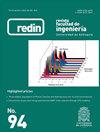库存持有成本对供应链战略设计的影响
IF 0.5
Q3 ENGINEERING, MULTIDISCIPLINARY
Revista Facultad De Ingenieria-universidad De Antioquia
Pub Date : 2020-06-18
DOI:10.17533/udea.redin.20200692
引用次数: 0
摘要
赤色;inventarios;optimizacion;摘要:在供应链战略设计中,库存持有成本的明确考虑在科学文献中还没有得到充分的解决。一个可能的原因是,供应链优化模型通常是确定性的线性模型或混合整数线性模型,而预测方法和库存控制系统是随机的非线性模型。然而,很明显,库存成本可能会对最佳供应链配置和分销系统的扩张或收缩产生重大影响。本文提出了一种实用的策略,通过蒙特卡罗仿真模型作为起点,考虑逐件库存控制系统,将库存持有成本纳入供应链优化模型。分析了将库存成本纳入目标函数的三种策略:均方根定律、平均库存与仓库吞吐量的潜在关联函数以及通过仿真估算平均库存。结果表明,SRL不应该被使用,除非不寻常的假设成立,潜在函数是一个非常好的近似值来考虑供应链配置的库存成本。本文章由计算机程序翻译,如有差异,请以英文原文为准。
The impact of inventory holding costs on the strategic design of supply chains
Red de abastecimiento; inventarios; optimización; modelos de simulación ABSTRACT: The explicit consideration of inventory holding costs for the strategic design of supply chains has not been sufficiently addressed in scientific literature. A possible cause is that usually supply chain optimization models are deterministic and linear or mixed-integer linear, while forecasting methods and inventory control systems are stochastic and non-linear. It is clear, however, that inventory costs might have a significant impact on optimal supply chain configuration and on distribution systems expansion or contraction. This article presents a practical strategy that considers an item-by-item inventory control system by means of a Monte Carlo simulation model as a starting point to include inventory holding costs in a supply chain optimization model. Three strategies to include inventory costs in the objective function were analyzed: The Square Root Law (SRL), the potential functions that relate average inventory with warehouse throughput, and the estimation of average inventories by simulation. The results suggest that the SRL should not be used unless unusual assumptions hold and that potential functions are a very good approximation to consider inventory costs for supply chain configuration.
求助全文
通过发布文献求助,成功后即可免费获取论文全文。
去求助
来源期刊
CiteScore
2.00
自引率
0.00%
发文量
27
审稿时长
2 months
期刊介绍:
Revista Facultad de Ingenieria started in 1984 and is a publication of the School of Engineering at the University of Antioquia.
The main objective of the journal is to promote and stimulate the publishing of national and international scientific research results. The journal publishes original articles, resulting from scientific research, experimental and or simulation studies in engineering sciences, technology, and similar disciplines (Electronics, Telecommunications, Bioengineering, Biotechnology, Electrical, Computer Science, Mechanical, Chemical, Environmental, Materials, Sanitary, Civil and Industrial Engineering).
In exceptional cases, the journal will publish insightful articles related to current important subjects, or revision articles representing a significant contribution to the contextualization of the state of the art in a known relevant topic. Case reports will only be published when those cases are related to studies in which the validity of a methodology is being proven for the first time, or when a significant contribution to the knowledge of an unexplored system can be proven.
All published articles have undergone a peer review process, carried out by experts recognized for their knowledge and contributions to the relevant field.
To adapt the Journal to international standards and to promote the visibility of the published articles; and therefore, to have a greater impact in the global academic community, after November 1st 2013, the journal will accept only manuscripts written in English for reviewing and publication.
Revista Facultad de Ingeniería –redin is entirely financed by University of Antioquia
Since 2015, every article accepted for publication in the journal is assigned a DOI number.

 求助内容:
求助内容: 应助结果提醒方式:
应助结果提醒方式:


